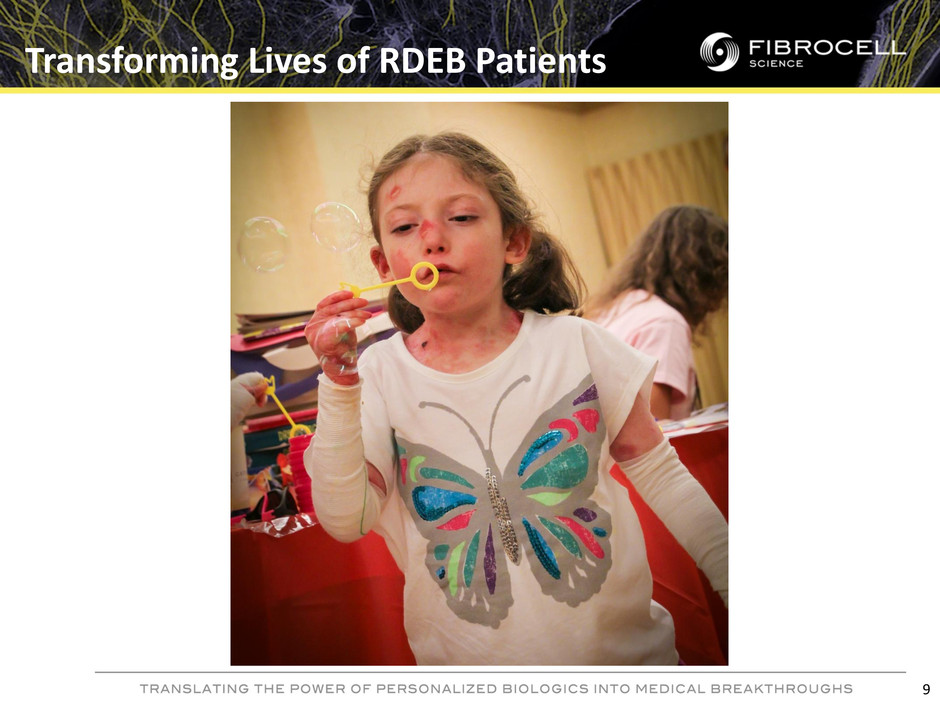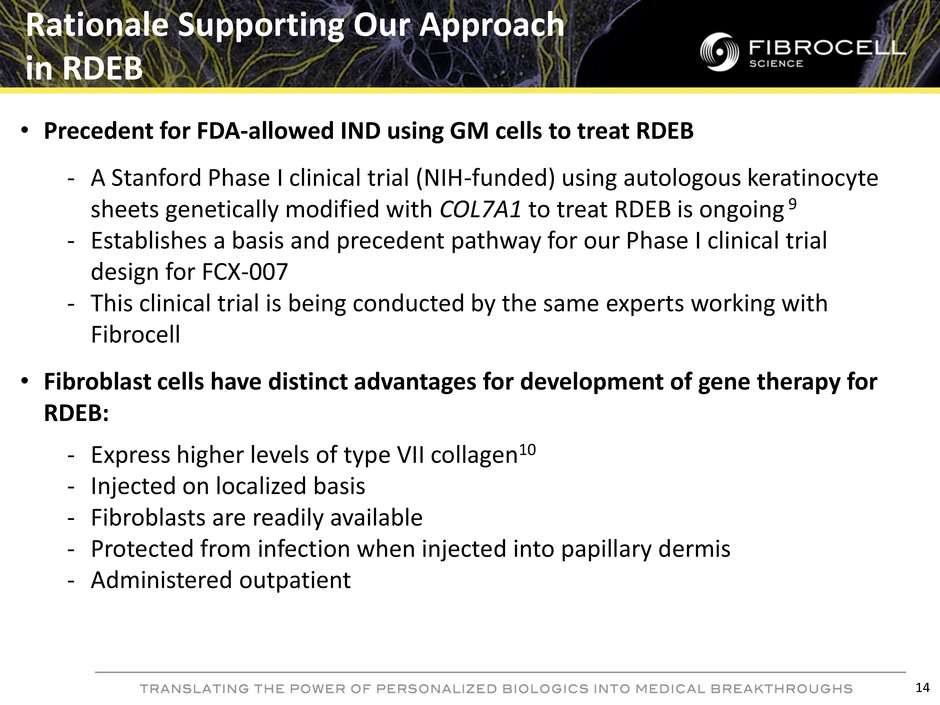
Fibrocell Corporate Presentation April 21, 2015 1

2 Forward-Looking Statements This presentation contains, and our officers and representatives may from time to time make, statements that are “forward-looking statements” within the meaning of the safe harbor provisions of the U.S. Private Securities Litigation Reform Act of 1995. Examples of forward-looking statements include, among others, statements we make regarding our development strategy, timing and potential advantages of our product candidates. These forward-looking statements rely on a number of assumptions concerning future events and are subject to a number of risks, uncertainties, and other factors, many of which are outside of Fibrocell’s control. Important factors that could cause our actual results and financial condition to differ materially from those indicated in the forward-looking statements include, among others, the following: (i) uncertainties relating to the initiation and completion of clinical trials; and (ii) whether clinical trial results will validate and support the safety and efficacy of our product candidates, as well as those set forth under the caption “Item 1A. Risk Factors” in Fibrocell Science’s most recent Form 10-K filing. Any forward-looking statement made by us in this presentation is based only on information currently available to us and speaks only as of the date on which it is made. In addition, Fibrocell operates in a highly competitive and rapidly changing environment, and new risks may arise. Accordingly, you should not place any reliance on forward-looking statements as a prediction of actual results. Fibrocell disclaims any intention to, and undertakes no obligation to, update or revise any forward-looking statement. You are also urged to carefully review and consider the various disclosures in Fibrocell’s most recent annual report on Form 10-K, our most recent Form 10-Q as well as other public filings with the SEC since the filing of Fibrocell’s most recent annual report.

• Fibrocell is the scientific leader of autologous fibroblast therapy for skin and connective tissue diseases • Developing a pipeline of gene therapies for orphan skin diseases using autologous fibroblasts to deliver the targeted gene • FCX-007: Novel gene-therapy drug candidate for Recessive Dystrophic Epidermolysis Bullosa (RDEB), a congenital orphan skin disease – Devastating, progressive, painful blistering disease that leads to death – Collaboration with Intrexon (NYSE: XON); IND planned mid-2015, Phase I in 2H15 • FCX-013: Novel gene-therapy drug candidate for Linear Scleroderma, an orphan skin disease – Autoimmune disease causes debilitating, painful linear scars and skin thickening that can lead to pain, reduced joint mobility and deformity – Collaboration with Intrexon; IND planned for 2016 • Phase II azficel-T sBLA program: autologous fibroblasts for Dysphonia (significant voice impairment as a result of vocal cord scarring or atrophy) Investment Highlights 3

The Science of Autologous Fibroblasts • Fibroblasts repair tissue infrastructure by producing extracellular matrix proteins including collagen and growth factors • Most common cell in skin and connective tissue • Fibroblasts have distinct advantages for treatment of skin diseases ‐ Autologous cells reduce risk of patient rejection ‐ Localized injections avoid systemic treatment — may provide more control and sustained delivery of targeted protein at site of disease • Our proprietary technology is used to create personalized biologics 4

Gene Therapy Product Engine integrates Intrexon’s synthetic biology FCX-007, FCX-013 Autologous Fibroblast Product Engine azficel-T BLA Two Product Engines – Multiple Therapeutics in Development Collection Culture Local Administration Vector Preparation Gene Packaging Gene Transduction Personalized Biologics Approach 5

Key Relationships • Intrexon Corporation (NYSE: XON) – Development of gene therapies for orphan skin & connective tissue diseases • Stanford University – Lead center for development of FCX-007 • UCLA – Cell growth media research & development to optimize gene and cell therapies 6

Personalized Biologics Indication Pre-Clinical Development Phase 1 Phase 2 Phase 3 azficel-T sBLA Dysphonia FCX-007 Gene-Therapy Orphan Drug Candidate Recessive Dystrophic Epidermolysis Bullosa (RDEB) FCX-013 Gene-Therapy Orphan Drug Candidate Linear Scleroderma Development Pipeline 7

Advantages of Our Approach • Criteria to pursue orphan indications: ‐ Unmet medical need ‐ Market opportunity/value proposition ‐ Technical feasibility ‐ Validated animal models ‐ Biologic precedent • Advantages of autologous fibroblast/gene-therapy approach: ‐ Localized injection (avoids systemic delivery) ‐ Reduced rejection concern ‐ More control and sustained delivery of protein targets 8

Transforming Lives of RDEB Patients 9

Recessive Dystrophic Epidermolysis Bullosa • RDEB patients are not producing type VII collagen (COL7) due to mutation in COL7A1 gene ‐ Main component of anchoring fibrils that connect skin layers • Autologous human dermal fibroblasts transduced with a vector containing the gene for COL7A1 ‐ Administered locally to the papillary dermis via injection 10

Disease Current Treatments Epidemiology • Devastating, progressive, painful blistering disease that leads to death • Diagnosed at infancy • High mortality rate • Cause: A mutation in the COL7A1 gene which encodes for COL7 • Current treatments only address symptoms, not underlying disease • Bandaging & antibiotics – up to $20,000 per month • Feeding tubes • Surgery, including hand and esophageal Dystrophic EB (DEB) ~5,500 – 12,500 US1 • RDEB ~1,100 – 2,500 US2 • DDEB ~4,400 – 10,000 US3 Recessive Dystrophic Epidermolysis Bullosa 11

FCX-007 Development Update Product Development Clinical Development Phase I Clinical Study Initiation, 2H 2015 IND Filing, mid-2015 Gained Clearance from Recombinant DNA Advisory Committee (RAC), Feb 2015 Pre-Clinical Studies – In Progress Pre-IND Meeting with FDA, Aug 2014 Orphan Drug Approval, June 2014 Complete Engineering Runs Develop Assays for Potency and Safety Select Contract Manufacturing Organization Transfect Gene into Target Cell Optimize Cell Culture Conditions Select Gene Delivery System Select Gene Target and Create Gene Construct 12

• Multiple published studies in previous animal models4,5,6 demonstrate that fibroblasts genetically modified with COL7A1 ‐ Deposited type VII collagen and formed anchoring fibrils at the dermal-epidermal junction ‐ Exhibited stable expression ‐ Corrected blistering • Autologous cells are preferred over allogeneic cells due to increased proliferation, less inflammation and lack of immunogenic response2,7,8 Research Studies Support Our Approach in RDEB 13

• Precedent for FDA-allowed IND using GM cells to treat RDEB ‐ A Stanford Phase I clinical trial (NIH-funded) using autologous keratinocyte sheets genetically modified with COL7A1 to treat RDEB is ongoing 9 ‐ Establishes a basis and precedent pathway for our Phase I clinical trial design for FCX-007 ‐ This clinical trial is being conducted by the same experts working with Fibrocell • Fibroblast cells have distinct advantages for development of gene therapy for RDEB: ‐ Express higher levels of type VII collagen10 ‐ Injected on localized basis ‐ Fibroblasts are readily available ‐ Protected from infection when injected into papillary dermis ‐ Administered outpatient Rationale Supporting Our Approach in RDEB 14

Disease Epidemiology • Excess production of extracellular matrix characterized by skin fibrosis and linear scars • The linear areas of skin thickening may extend to underlying tissue and muscle in children which may impair growth in affected legs and arms or forehead • Lesions appearing across joints impair motion and may be permanent • Localized Scleroderma ~200,000 sufferers US11 comprised of many different sub-types - Linear Scleroderma Initial target for FCX-013 is a group of ~40,000 patients who have scleroderma over a major joint and exhibit severe joint pain11 Current Treatments • Current treatments only address symptoms • Systemic or topical corticosteroids • UVA light therapy • Physical therapy Linear Scleroderma Photo: © 2015 American College of Rheumatology. Used with permission. 15

Disease Current Treatments Epidemiology Damage to the fibroblast layer causes scarring and edema which limits air flow and results in severe and significant limitations in voice quality, often loss of voice • Current treatments only address symptoms, not underlying disease • Voice therapy • Surgery - Injection (collagen, fat, calcium, hyaluronic acid) - Implant (PTFE, silastic) ~146,000 people suffer from chronic or severe dysphonia, as would occur with vocal cord scarring12 Dysphonia 16

Positive Phase I clinical trial results published in peer-reviewed journal13 • All patients completed the clinical trial, successive injections of autologous fibroblasts were well-tolerated, and no serious adverse events reported; n=5 • Statistically significant and sustained improvement – Efficacy analysis for wave grade improvements was significant starting in month 3 of the 12 month clinical trial (p=0.04) – Voice Handicap Index and Voice Quality assessments showed an improvement in voice quality overall for the duration of the clinical trial 17 Clinical Data Support Our Approach in Dysphonia

• Enrollment of 22 subjects as of 21 April 2015 • Multi-center trial: 3 major sites • Double-blind, randomized, placebo-controlled, 20 subjects • Validated scales with a 4-month efficacy endpoint • Dosing expected to be complete by year end Dysphonia Phase II 18

• Cash = $37.5 million at 31 Dec 2014 • NASDAQ listed: FCSC • 41 million common shares outstanding - 6.0 million warrants; 2.1 million options • Analyst research - Wedbush Securities — David Nierengarten, PhD - Griffin Securities — Keith Markey, PhD • HQ facility: Exton, PA • ~50 employees Financial and Corporate Information 19

• Fibrocell is the scientific leader of autologous fibroblast therapy for skin and connective tissue diseases • Developing a pipeline of gene therapies for orphan skin diseases using autologous fibroblasts to deliver the targeted gene • FCX-007: Novel gene-therapy drug candidate for Recessive Dystrophic Epidermolysis Bullosa (RDEB), a congenital orphan skin disease – Devastating, progressive, painful blistering disease that leads to death – Collaboration with Intrexon (NYSE: XON); IND planned mid-2015, Phase I in 2H15 • FCX-013: Novel gene-therapy drug candidate for Linear Scleroderma, an orphan skin disease – Autoimmune disease causes debilitating, painful linear scars and skin thickening that can lead to pain, reduced joint mobility and deformity – Collaboration with Intrexon; IND planned for 2016 • Phase II azficel-T sBLA program: autologous fibroblasts for Dysphonia (significant voice impairment as a result of vocal cord scarring or atrophy) Investment Highlights 20

References 1DEBRA International DEBRA International. What is EB Infographic. http://www.debra- international.org/epidermolysis-bullosa.html. Accessed 10/06/2014. 2 Petrof G., et. al. Fibroblast cell therapy enhances initial healing in recessive dystrophic epidermolysis bullosa wounds: results of a randomised, vehicle-controlled trial. Brit J Dermatol. 2013 Nov;169(5):1025-33. 3 Calculated as follows: 25% of DEB - 5% RDEB = 20% DDEB. 4Ortiz-Urda S. et al. Injection of genetically engineered fibroblasts corrects regenerated human epidermolysis bullosa skin tissue. J Clin Invest. 2003. 111:251–255. 5Woodley DT. et. al. Normal and gene-corrected dystrophic epidermolysis bullosa fibroblasts alone can produce type VII collagen at the basement membrane zone. Journal of Investigative Dermatology 121(5):1021-1028, 2003. 6Chen M et al. NC1 domain of type VII collagen binds to the beta 3 chain of laminin 5 via a unique subdomain within the fibronectin-like repeats. Journal of Investigative Dermatology 112(2):177-83, 1999. 7Morimoto N. et. al.; Viability and function of autologous and allogeneic fibroblasts Seeded in dermal substitutes after implantation. J Surg Res. 2005 May 1;125(1):56-67. 8 Lamme, E. N., Van Leeuwen, R. T. J., Mekkes, J. R. and Middelkoop, E. (2002), Allogeneic fibroblasts in dermal substitutes induce inflammation and scar formation. Wound Repair and Regeneration, 10: 152-160. 9 ClinicalTrials.gov reference#: NCT01263379. 10 Goto, M., et al. Fibroblasts show more potential as target cells than keratinocytes in COL7A1 gene therapy of dystrophic epidermolysis bullosa. Journal of Investigative Dermatology. 126(4):766-772, 2006. 11The Scleroderma Foundation. What is Scleroderma? www.scleroderma.orgl; accessed 10/09/201op4. States that systemic scleroderma is one third of all scleroderma cases. 12 Cohen S. M., et al. Prevalence and causes of dysphonia in a large treatment-seeking population. The Laryngoscope 122(2):343-348, 2012. 13 Chhetri, Dinesh, Injection of Cultured Autologous Fibroblasts for Human Vocal Fold Scars. The Laryngoscope 121(4):785-792, 2011. 21




















